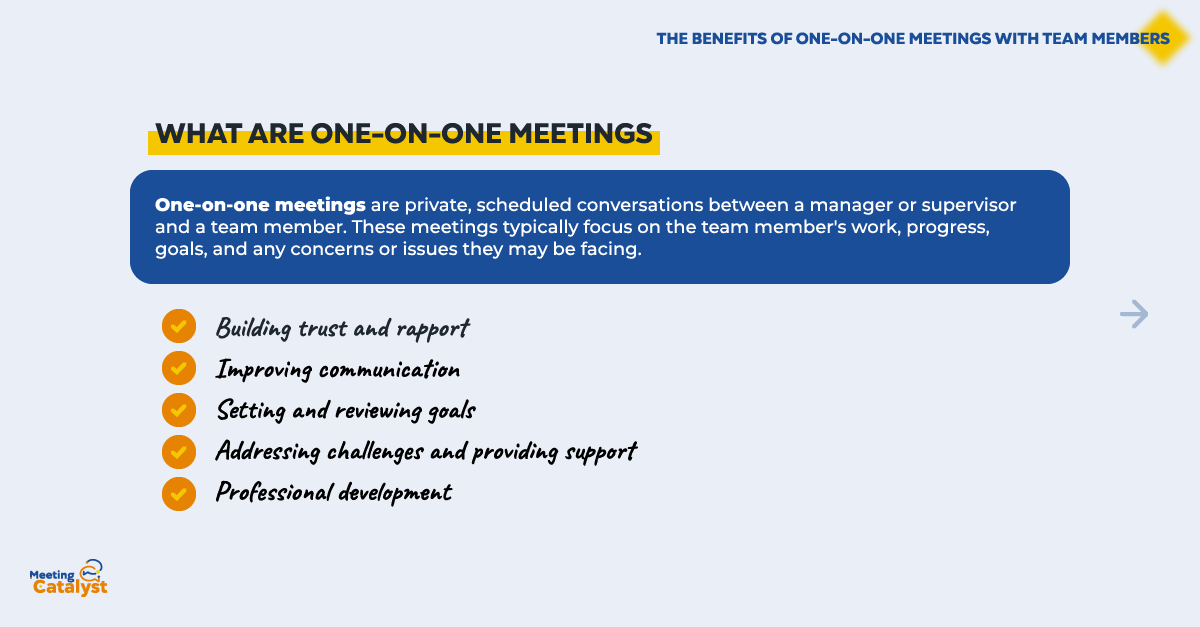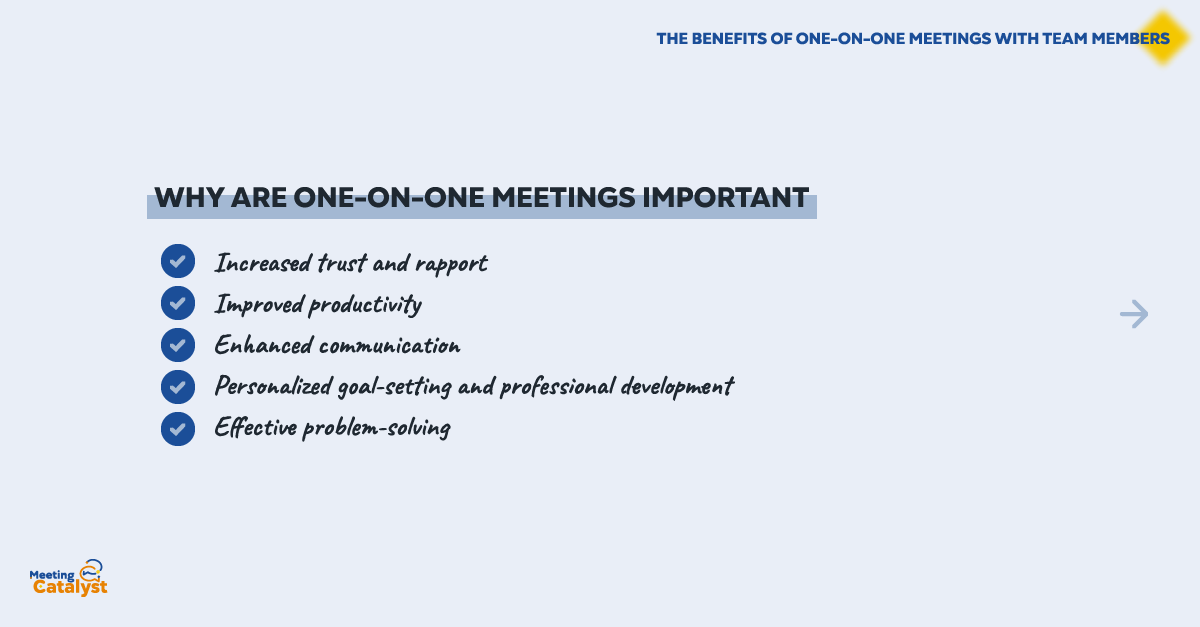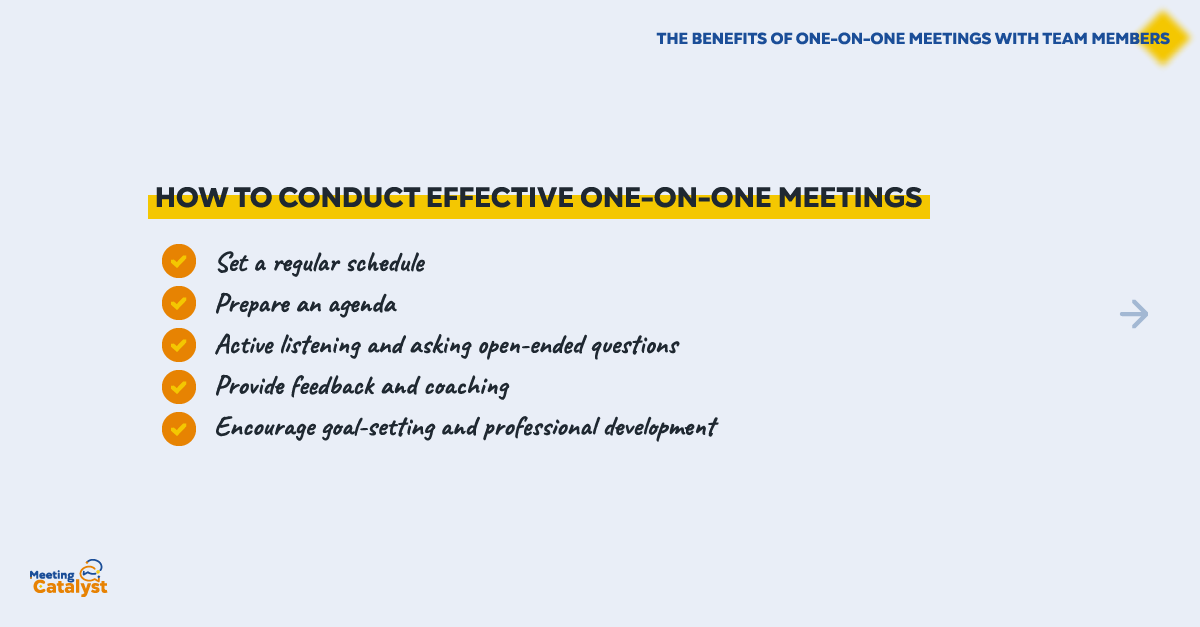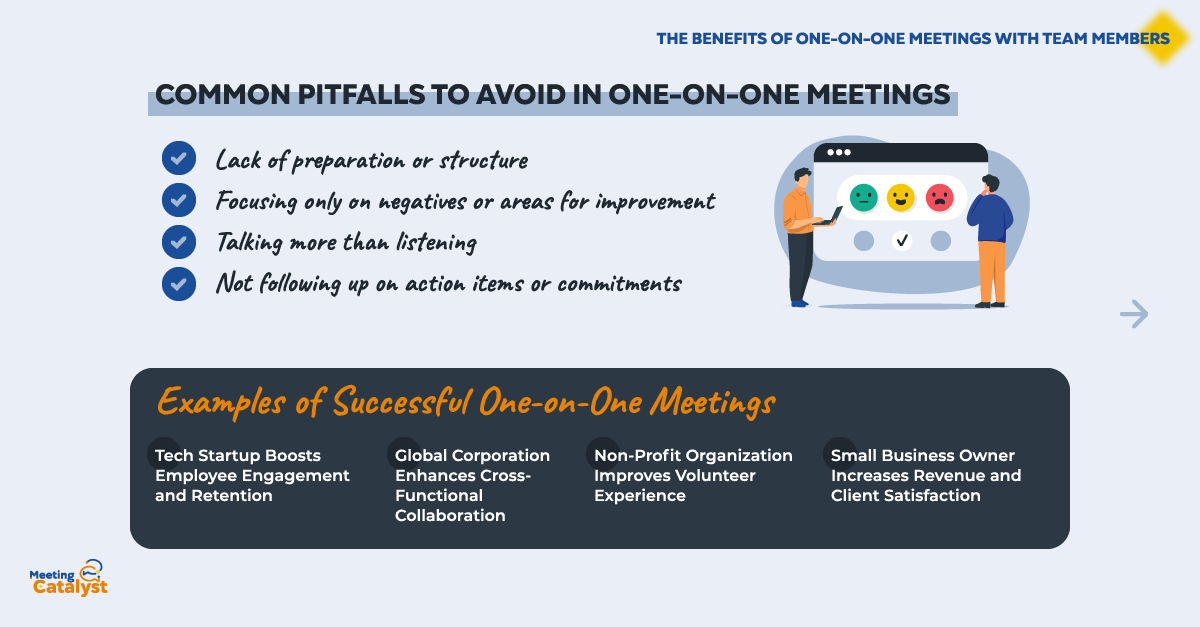The Benefits of One-on-One Meetings with Team Members


Introduction
Effective communication and collaboration are the cornerstones of a successful workplace. In a fast-paced and complex business environment, it's crucial for leaders to maintain open lines of communication with their team members, fostering trust and productivity. One powerful tool for achieving this is the one-on-one meeting.
In this article, we'll explore the benefits of one-on-one meetings with team members and provide practical guidance on how to conduct them effectively. We'll cover topics such as the importance of these meetings, how to conduct them, common pitfalls to avoid, and real-world examples of successful implementation. By the end of this article, you'll have a solid understanding of the benefits and best practices for one-on-one meetings, and be ready to start implementing them with your own team.
What Are One on One Meetings?

One-on-one meetings are private, scheduled conversations between a manager or supervisor and a team member. These meetings typically focus on the team member's work, progress, goals, and any concerns or issues they may be facing. One-on-one meetings differ from group meetings or team huddles, as they provide a dedicated space for individualized attention and discussion.
The purpose and benefits of one-on-one meetings include:
Building trust and rapport: One-on-one meetings create a safe environment for team members to openly discuss their thoughts, concerns, and aspirations, fostering stronger relationships between managers and their direct reports.
Improving communication: Regular one-on-one meetings help to ensure that both parties are on the same page, promoting open dialogue and preventing misunderstandings.
Setting and reviewing goals: These meetings offer an opportunity to discuss individual goals, track progress, and provide support for achieving those objectives.
Addressing challenges and providing support: One-on-one meetings enable team members to share any obstacles they're facing and receive guidance on how to overcome them.
Professional development: Managers can use one-on-one meetings to help team members identify areas for growth and provide coaching, resources, or training to support their development.
In summary, one-on-one meetings are an essential tool for managers and supervisors to maintain strong communication and support their team members on an individual level.
Why Are One on One Meetings Important?

One-on-one meetings play a crucial role in fostering a healthy and productive work environment. They benefit both team members and managers by promoting open communication, trust, and growth. Here are some specific reasons why one-on-one meetings are essential:
Increased trust and rapport: Establishing a strong bond between managers and team members is vital for effective collaboration. One-on-one meetings allow both parties to share their thoughts and concerns openly, building trust and strengthening their working relationship.
Improved productivity: When team members feel heard and supported, they are more likely to be engaged and motivated to perform at their best. Regular one-on-one meetings help to ensure that any roadblocks are promptly addressed, allowing team members to focus on their tasks and achieve their goals.
Enhanced communication: One-on-one meetings provide an opportunity for open and honest dialogue, ensuring that both parties are aligned and working towards shared objectives. This improved communication can prevent misunderstandings and foster a more collaborative work environment.
Personalized goal-setting and professional development: During one-on-one meetings, managers can help team members set realistic, achievable goals tailored to their individual strengths and areas for growth. Managers can also provide guidance and resources to support their team members' professional development.
Effective problem-solving: One-on-one meetings give team members a chance to raise concerns or issues they might be experiencing. Managers can then work with the team member to find solutions, address challenges, and ensure a positive work experience.
By incorporating regular one-on-one meetings into your management routine, you can significantly improve communication, goal-setting, and professional development within your team. These meetings lead to increased trust, productivity, and engagement, ultimately resulting in a more successful and harmonious work environment.
How to Conduct Effective One-on-One Meetings

Conducting effective one-on-one meetings is crucial for maximizing their benefits. Here are some tips and strategies to ensure that your meetings are productive and valuable for both you and your team members:
Set a regular schedule: Establishing a consistent schedule for one-on-one meetings demonstrates your commitment to open communication and support. This consistency also helps to create a sense of predictability and stability, allowing team members to prepare for and look forward to these meetings.
Prepare an agenda: Before each meeting, develop a clear agenda that outlines the topics you want to cover. Share the agenda with your team member in advance, so they have time to gather their thoughts and come prepared with any relevant questions or concerns.
Active listening and asking open-ended questions: Foster an open and honest dialogue by practicing active listening and asking open-ended questions. This approach encourages team members to share their thoughts and feelings, allowing you to gain a deeper understanding of their perspectives and experiences.
Provide feedback and coaching: Use one-on-one meetings as an opportunity to offer constructive feedback on your team member's performance, focusing on both their strengths and areas for improvement. Be specific and provide guidance on how they can enhance their skills or address challenges.
Encourage goal-setting and professional development: Help your team members set realistic, achievable goals that align with their individual strengths and growth areas. Discuss potential professional development opportunities, such as training or mentorship programs, to support their ongoing growth and success.
By implementing these strategies, you can ensure that your one-on-one meetings are effective, meaningful, and beneficial for both you and your team members. These meetings will foster a culture of open communication, trust, and growth, ultimately leading to a more productive and harmonious work environment.
Common Pitfalls to Avoid in One-on-One Meetings

While one-on-one meetings can be incredibly beneficial, it's important to be aware of common mistakes and challenges that can hinder their effectiveness. Here are some pitfalls to avoid when conducting one-on-one meetings with your team members:
Lack of preparation or structure: Failing to prepare for a meeting or having a loosely structured agenda can lead to unproductive and unfocused conversations. To avoid this, create a clear agenda beforehand, share it with your team member, and stick to the topics you've outlined during the meeting.
Focusing only on negatives or areas for improvement: While discussing areas for improvement is necessary, concentrating solely on these aspects can be demoralizing for your team member. Balance your feedback by highlighting their strengths and accomplishments, as well as discussing opportunities for growth.
Talking more than listening: One-on-one meetings should be a two-way conversation. Dominating the discussion by talking more than listening can make your team member feel unheard and undervalued. Practice active listening, ask open-ended questions, and give your team member ample time to express their thoughts and concerns.
Not following up on action items or commitments: One-on-one meetings should result in actionable outcomes. Failing to follow up on commitments or action items can lead to a loss of trust and reduced accountability. After each meeting, document the agreed-upon action items and track their progress to ensure that both you and your team member are accountable for the outcomes.
By being aware of these common pitfalls and taking proactive steps to avoid them, you can ensure that your one-on-one meetings are effective, productive, and valuable experiences for both you and your team members. These meetings will contribute to building a strong foundation for communication, trust, and growth within your team.
Examples of Successful One-on-One Meetings
To illustrate the potential impact of well-executed one-on-one meetings, let's explore a few real-world examples of organizations that have successfully implemented these meetings and the benefits they have experienced as a result:
Tech Startup Boosts Employee Engagement and Retention: A fast-growing technology startup recognized that they were struggling with employee engagement and retention. By implementing regular one-on-one meetings between managers and team members, they were able to address individual concerns and provide personalized coaching. As a result, employee satisfaction increased, and the company saw a significant reduction in turnover rates.
Global Corporation Enhances Cross-Functional Collaboration: A large multinational corporation faced challenges with cross-functional collaboration among its various departments. By encouraging one-on-one meetings between team members from different departments, they were able to foster better understanding, knowledge-sharing, and cooperation among their employees, leading to improved overall efficiency and innovation.
Non-Profit Organization Improves Volunteer Experience: A non-profit organization, relying heavily on volunteers, noticed that some of their volunteers felt disconnected from the organization's mission and leadership. By implementing one-on-one meetings between volunteer coordinators and volunteers, they were able to provide personalized support, feedback, and recognition, ultimately increasing volunteer satisfaction and commitment to the organization's mission.
Small Business Owner Increases Revenue and Client Satisfaction: A small business owner, providing consulting services, found that their revenue and client satisfaction levels had plateaued. By conducting one-on-one meetings with each team member, the owner was able to identify areas for improvement, provide tailored coaching, and align individual goals with company objectives. This resulted in increased revenue, improved client satisfaction, and a more cohesive, motivated team.
These examples demonstrate the wide-ranging benefits of one-on-one meetings in various organizational settings. By prioritizing and effectively conducting these meetings, business and team leaders can unlock their team's full potential, improve communication, and foster a culture of trust and growth.
Conclusion
In conclusion, one-on-one meetings with team members are an invaluable tool for effective communication and collaboration in the workplace. By fostering an environment of trust, open dialogue, and continuous improvement, these meetings can lead to increased productivity, employee engagement, and overall success for both the team member and the organization.
To recap, the key benefits of one-on-one meetings include:
- Enhanced understanding and alignment of individual and organizational goals
- Improved communication and collaboration between team members and managers
- Greater opportunities for coaching, feedback, and professional development
- Higher levels of employee satisfaction, motivation, and retention
As a business or team leader, now is the time to prioritize and implement one-on-one meetings with your team members. By following the tips and strategies outlined in this article, you can create an environment where employees feel heard, valued, and supported in their growth and development.
So, take action today and start reaping the benefits of one-on-one meetings in your organization. Your team members, and your bottom line, will thank you for it.